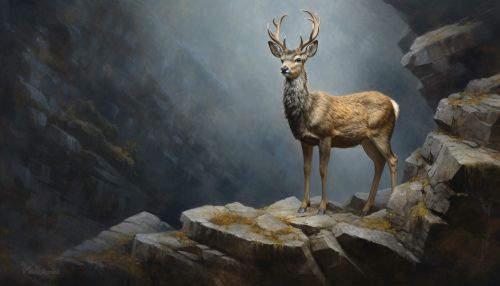Bharal
Taxonomy and Description
The Bharal, also known as the Himalayan blue sheep or naur, is a species of caprid (goat-antelope) native to the high Himalayas of Nepal, Bhutan, Tibet, India, Pakistan, and China. It is classified under the genus Pseudois and the family Bovidae. The scientific name of the species is Pseudois nayaur. Bharal exhibit sexual dimorphism, with males being larger than females and possessing larger horns.


Physical Characteristics
Bharal are medium-sized animals, with a body length ranging from 115 to 165 cm, shoulder height from 69 to 91 cm, and weight from 35 to 75 kg. The males are generally larger and heavier than the females. They have a stout body with a thick coat of fur, which varies in color from slate grey to dark brown, with a bluish tinge. The underparts and the insides of the legs are white. The males have large, curved horns that can grow up to 80 cm in length, while the females have shorter, straighter horns.
Habitat and Distribution
Bharal inhabit the high mountain regions of the Himalayas, typically at altitudes between 3,000 and 5,500 meters. They are well-adapted to the harsh, cold climate and rugged, rocky terrain of their habitat. They are found in a variety of habitats, including alpine meadows, steep rocky cliffs, and semi-desert regions.
Behavior and Ecology
Bharal are diurnal animals, most active in the early morning and late afternoon. They are excellent climbers and jumpers, capable of negotiating the steep, rocky terrain of their habitat with ease. They live in herds, which can range from a few individuals to over a hundred. The composition of the herds varies, with separate herds for males, females, and young ones.
Diet
Bharal are herbivores, feeding mainly on grasses, herbs, and lichens. During the winter, when vegetation is scarce, they may also consume twigs and leaves of shrubs and trees.
Reproduction
The mating season for Bharal is usually in November and December. After a gestation period of about six months, the females give birth to one or two young ones, usually in June or July. The young ones are weaned at about six months of age and reach sexual maturity at around two years of age.
Conservation Status
The Bharal is listed as a species of Least Concern by the International Union for Conservation of Nature (IUCN). However, it faces threats from habitat loss due to overgrazing by domestic livestock, competition for food resources, and hunting for its meat and horns.
Cultural Significance
In many parts of its range, the Bharal is an important part of local culture and folklore. It is often depicted in local art and literature, and its meat is considered a delicacy in some areas.
